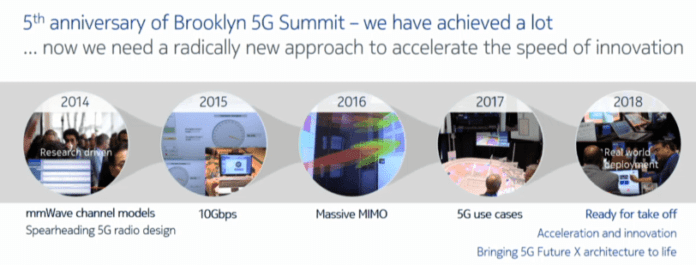Equipment vendors envisage automated networks of a million slices
The conference portion of the Brooklyn 5G Summit began with a bit of nostalgia befitting the show’s modest, but pertinent milestone of its fifth annual gathering. The show began with Marcus Weldon, Nokia’s CTO and president of Bell Labs, and Marc Rouanne, president of mobile networks for Nokia — two heavyweight speakers from one of the show’s anchor sponsors — providing a brief recap of the major themes from each of the previous four gatherings (see slide above). By doing so, it reminded everyone that while the industry has been talking about 5G for some time, substantial progress must be made over the next few years in order to begin to realize the promise that the concept holds.
Tech-focused keynote highlights from Nokia
As should be expected from an equipment vendor tasked with pushing the discussion towards the proverbial horizon, Weldon and Rouanne from Nokia teamed up to kick off the proceedings with a healthy dose of the forward-looking. Both men focused their discussions on tech innovations related to open networking, and machine learning as a means of enabling massive network automation. The “end-game” envisioned was a fully automated 5G network capable of supporting a million fully automated slices within a single network. Taking things even further, some of these slices would support haptic interactions within the network (for those not familiar with “haptics”, think: your phone “tattooed” onto your arm with ink that enables the user to make and receive calls or even launch AR-fueled mapping features.)

Source: IEEE event live stream
By invoking some far-out concepts such as haptic, both presentations were able to underscore the need for an array of technology developments such as a programmable radio access network and core, pervasive software-defined-networking-based management and orchestration, and network decomposition based on microservices and continuously evolved via DevOps-style operations. Naturally, underpinning all of this automation is the pervasive use of cognitive networking based on artificial intelligence and machine learning.
Audience Q&A highlighted the need for 5G and the uncertainty about what 5G needs to be
After the keynotes, a round of presentations led by representatives from Huawei, Ericsson and Nokia focused on the technology features being incorporated into 5G New Radio development. Briefly summarized, these key features as presented by Huawei were grouped into 8 macro concepts:
- Software-defined air interfaces

Dr. Zhu from Huawei
Source: IEEE event live stream - New wave forms (e.g. OFDMA)
- New coding structures
- Ultra-low latency
- New transmission modes
- New access schemes
- Enhanced multiple-input multiple-output capabilities
- millimeter wave transmission
While these presentations provide an interesting look into how technology vendors are approaching the radio portion of 5G development, two audience questions during the ensuing panel discussion served as a reminder that while the industry is comfortable with the idea that the need for 5G is apparent, there remains substantial uncertainty over exactly what the standards will ultimately entail.
For example, during the Q&A, Chris Nicoll, an analyst with ACG Research, asked a question that spoke to the need for 5G versus the ability to continue to innovate within existing LTE technology. Briefly summarized, the answer given suggested that there are key capabilities demanded by 5G use cases that LTE would prove too cumbersome to adequately support. One example given was limitations in the ability for LTE technology to support the level of beam-forming that will be necessary to support some fundamental 5G use cases.
On the other hand, there was a question asked by Ken Rehbehn, founder of analyst firm CritComm Insights, regarding what appears to be an abundance of specs related to feature support in the 3GPP’s Release 16 specifications, which are expected in late 2019. The response given suggested that while the framework being drawn up for Release 16 will likely focus on features related to support for requirements in specific vertical industries – industrial automation was cited as an example – the full variety of specs for which features will be included are yet unknown.
The answers to both questions, when viewed vis-à-vis one another, seem to indicate that while the industry is confident that LTE will not serve as a material impediment to 5G development momentum, many key details of that development are still a ways off from being codified into standards.

